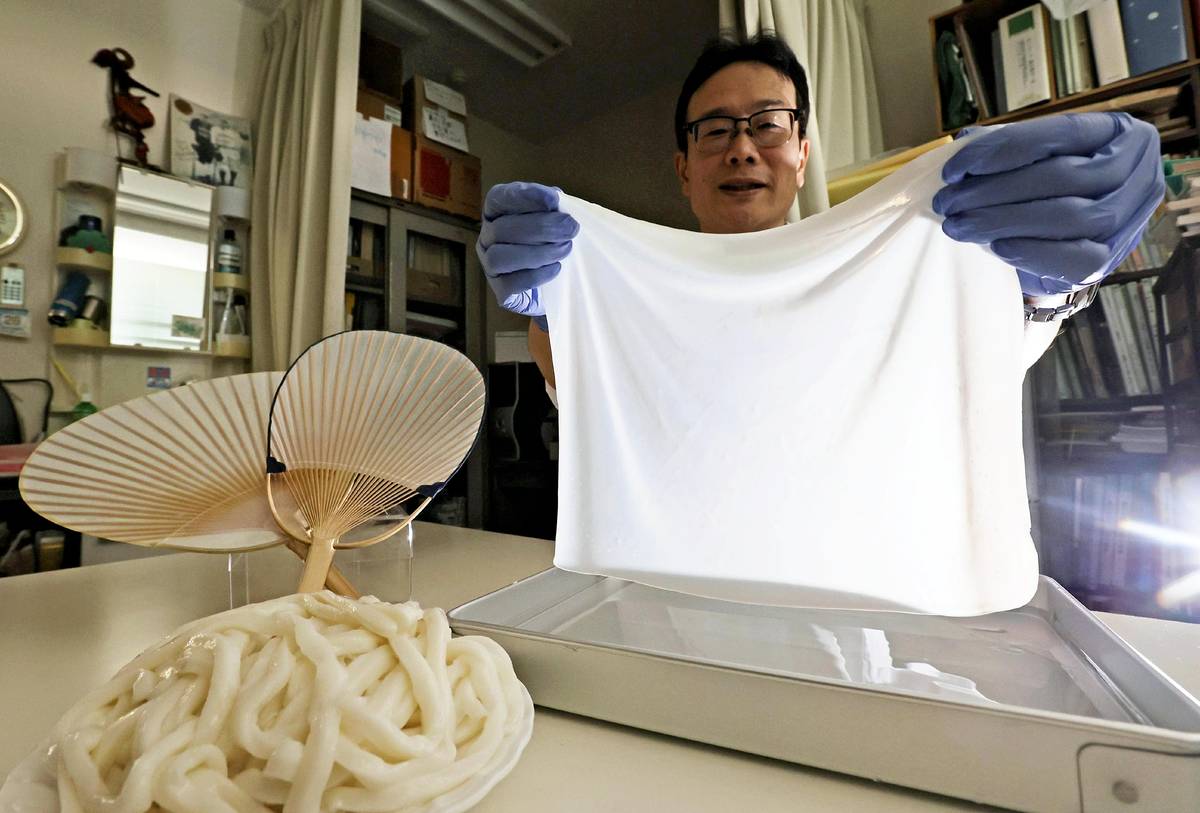Kagawa: Technology Developed to Make Paper Out of Udon Noodles Set for Disposal; Thinner, Lighter than Ordinary Paper

Kagawa University Prof. Naotaka Tanaka holds a sheet of paper made from Sanuki udon in Miki, Kagawa Prefecture.
10:24 JST, December 21, 2024
TAKAMATSU — A technology was developed to make paper using udon noodles set to be discarded in Kagawa Prefecture, famous for the chewy Sanuki udon, and preparations are underway to put the tech into practical use.
The technology was developed by Naotaka Tanaka, a professor in Kagawa University’s Faculty of Agriculture who specializes in applied microbiology. According to Tanaka, the udon noodles and water are mixed in a blender first, then an enzyme is added to produce glucose. When microorganisms are cultivated using the glucose as a nutrient, cellulose membranes are produced. The membranes form paper when dried.
Kagawa Prefecture, which calls itself “Udon Prefecture,” has the largest number of soba and udon restaurants per 10,000 people in Japan. Since Sanuki udon takes a long time to boil, it is common for udon restaurants to boil the noodles in advance so as not to keep customers waiting. However, since udon loses its chewiness and flavor over time and the noodles need to be consumed on the day they are made, a lot are often discarded at the end of the day. When converted into a flour equivalent, more than 3,000 tons are wasted each year.
Tanaka said that udon-based paper can be easily made without using paper-making equipment as the traditional paper-making process is not involved. Five to 10 sheets of A4-size paper can be produced from one serving of udon. The udon-based paper is thinner than ordinary copier paper, measuring up to 10% of its weight. It also does not tear easily when pulled, is water-resistant and can adhere to things when dampened.
A social welfare corporation took over developing products with the paper and began with using it for manufacturing traditional uchiwa fans. Next year, the corporation aims to commercialize Marugame Uchiwa, a specialty of Marugame in the prefecture, using the paper.
“A wide range of products can be made using the paper. I want to make this a new specialty product unique to the ‘Udon Prefecture,’” Tanaka said.
Related Tags
"Features" POPULAR ARTICLE
-

Sanrio to Open Museum in Yamanashi Pref. Dedicated to Founder, Exhibits Include Hello Kitty, Other Characters
-

Autumn Foliage Surrounds Visitors to Tokyo’s Showa Kinen Park
-

My Daughter No Longer Speaks to Me, But I Want to See Her and My Grandchild
-

Kumamoto: Public Bath Refurbished as Library Where You Can Chat, Take Photos
-

Frozen Vegetables: Demand Rises for Convenient, Tasty Domestic Produce
JN ACCESS RANKING
-

Keidanren Chairman Yoshinobu Tsutsui Visits Kashiwazaki-Kariwa Nuclear Power Plant; Inspects New Emergency Safety System
-

Imports of Rare Earths from China Facing Delays, May Be Caused by Deterioration of Japan-China Relations
-

University of Tokyo Professor Discusses Japanese Economic Security in Interview Ahead of Forum
-

Tokyo Economic Security Forum to Hold Inaugural Meeting Amid Tense Global Environment
-

Japan Pulls out of Vietnam Nuclear Project, Complicating Hanoi’s Power Plans

























